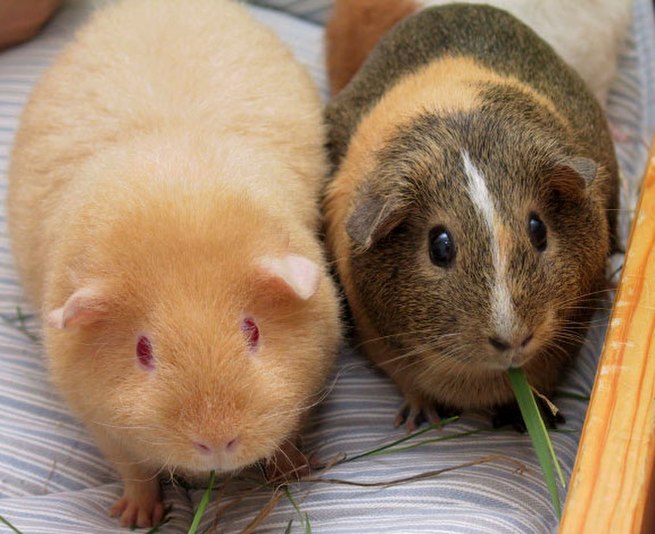
Main Difference
The main difference between Guinea Pig and Hamster is that the Guinea Pig is a species of mammal (domesticated guinea pig) and Hamster is a subfamily of mammals
-
Guinea Pig
The guinea pig or domestic guinea pig (Cavia porcellus), also known as cavy or domestic cavy, is a species of rodent belonging to the family Caviidae and the genus Cavia. Despite their common name, guinea pigs are not native to Guinea, nor are they biologically related to pigs, and the origin of the name is still unclear. They originated in the Andes of South America, and studies based on biochemistry and hybridization suggest they are domesticated descendants of a closely related species of cavy such as C. tschudii, and therefore do not exist naturally in the wild. They were originally domesticated as livestock, as a source of food, and continue to be.
In Western society, the domestic guinea pig has enjoyed widespread popularity as a pocket pet, a type of household pet, since its introduction by European traders in the 16th century. Their docile nature, friendly responsiveness to handling and feeding, and the relative ease of caring for them have made and continue to make guinea pigs a popular choice of pet. Organizations devoted to the competitive breeding of guinea pigs have been formed worldwide, and many specialized breeds with varying coat colors and textures are selected by breeders.
The domestic guinea pig plays an important role in folk culture for many indigenous Andean groups, especially as a food source, but also in folk medicine and in community religious ceremonies. The animals are used for meat and are a culinary staple in the Andes Mountains, where they are known as cuy. A modern breeding program was started in the 1960s in Peru that resulted in large breeds known as cuy mejorados (improved cuy) and prompted efforts to increase consumption of the animal outside South America.Biological experimentation on domestic guinea pigs has been carried out since the 17th century. The animals were so frequently used as model organisms in the 19th and 20th centuries that the epithet guinea pig came into use to describe a human test subject. Since that time, they have been largely replaced by other rodents such as mice and rats. However, they are still used in research, primarily as models for human medical conditions such as juvenile diabetes, tuberculosis, scurvy (like humans, they require dietary intake of vitamin C), and pregnancy complications.
-
Hamster
Hamsters are rodents (order Rodentia) belonging to the subfamily Cricetinae, which contains about 25 species classified in six or seven genera. They have become established as popular small house pets, but, because they are easy to breed in captivity, hamsters are also often used as laboratory animals.
Hamsters are more crepuscular than nocturnal and, in the wild, remain underground during the day to avoid being caught by predators. They feed primarily on seeds, fruits, and vegetation, and will occasionally eat burrowing insects. As one of their more prominent characteristics, they have elongated cheek pouches extending to their shoulders, which they use to carry food back to their burrows.
-
Guinea Pig (noun)
, noun.
-
Hamster (noun)
Any of various Old-World rodent species belonging to the subfamily Cricetinae.
“It is the cutest sight to see a hamster stuff his puffy cheeks with food; where is it going to store it?”
-
Hamster (noun)
Other rodents of similar appearance, such as the maned hamster or crested hamster, ver=161128, mouse-like hamsters of genus ver=161128, and the white-tailed rat (ver=161128).
